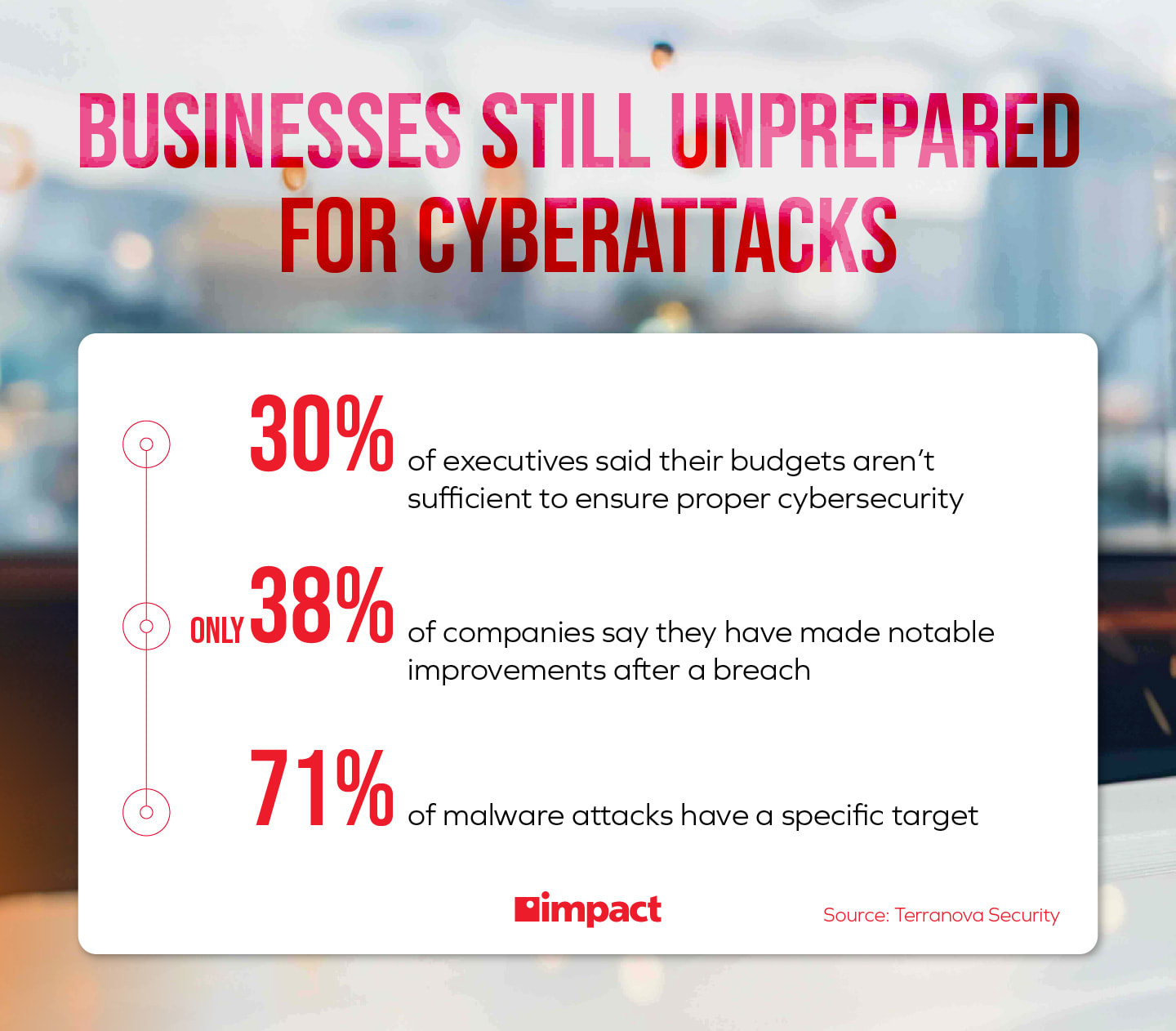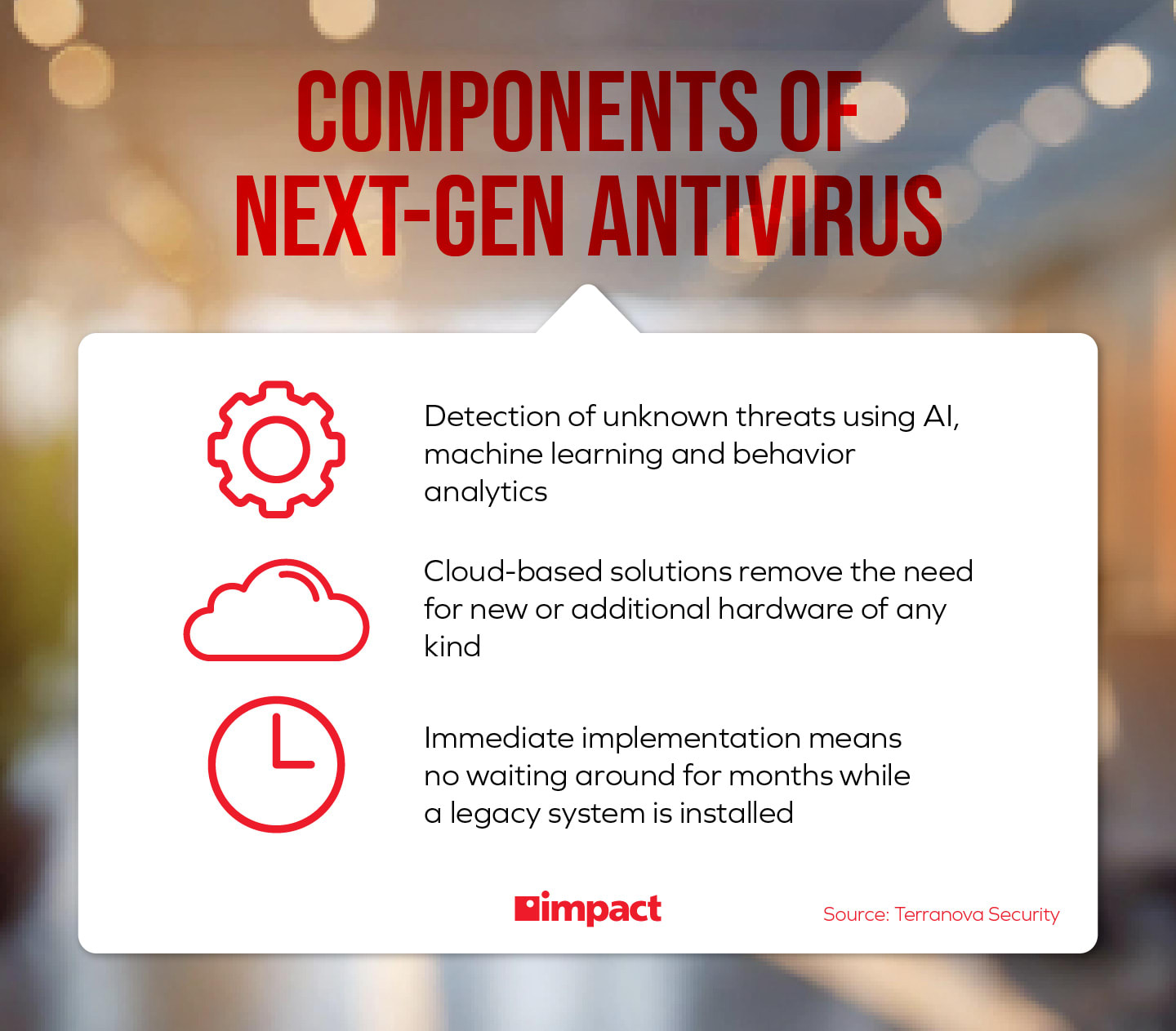Next-generation antivirus (NGAV) uses modern technologies like machine learning and artificial intelligence to proactively identify and neutralize both known and unknown cyber threats in almost real-time.
NGAV uses algorithms and predictive analytics that allow it to identify and respond to malicious behavior indicative of a cyber threat on the network. This software enhances the capabilities of traditional antivirus solutions that are designed to be more reactive than proactive.
Traditional antivirus software works by using known ”signatures” of various cyberthreats and attacks to identify malicious files. However, this requires the threat to have been logged, making traditional antivirus solutions fairly ineffective against new tactics, techniques, and procedures (TTPS) employed by threat actors.
The key advantage that next-gen antivirus brings to the table is its proactive threat identification and response.
For more information on the anatomy of a cyberattack and how they can be neutralized, watch Impact’s webinar, Dissecting Cybersecurity Breaches: How they Happen & How to Stop Them.
Why Is Next-Gen Antivirus an Important Aspect of Cybersecurity?
Next-gen antivirus has become a standard aspect of a modern cybersecurity strategy as the cyberthreats themselves continue to advance, becoming more sophisticated and harder to detect.
Staying ahead of cybercriminals launching new versions of phishing campaigns and advanced ransomware attacks has been a challenge. However, with tools like next-gen antivirus, businesses can use the same sophisticated technologies powering these cyberthreats to protect themselves.
While NGAV solutions are effective at identifying and neutralizing new threats that emerge, it is only one aspect of a comprehensive cybersecurity strategy. In order to make the most out of your NGAV tool, you should also pair this technology with additional cybersecurity measures to create a layered strategy.
Meeting New Demands
Next-gen antivirus uses advanced technology to provide a more comprehensive and proactive approach to malware protection.
With the increasing number of connected devices in every business, home, and pocket, there is a need to have antivirus protection on every device. But just installing regular antivirus software isn’t enough to provide the protection needed.
With technologies like machine learning, cloud scanning, and data analysis, next-gen antivirus takes the traditional antivirus experience and makes it fit to take on modern threats. Software with automatic features like incident remediation offer a much more user-friendly experience for IT experts, allowing them to more effectively monitor networks.
Instead of waiting for IT professionals to tackle a problem, next-gen antivirus programs are constantly learning, improving, and providing solutions to evolving security threats.
Next-Gen Antivirus vs Traditional Antivirus
The main difference between NGAV solutions and traditional antivirus tools is the proactive design of NGAV. Yet, that’s not their only difference. Join us below in exploring all the ways that traditional antivirus solutions and next-generation antivirus differ from one another.
Traditional Antivirus
Most people are familiar with traditional antivirus software. Plenty of people still use a traditional antivirus software in their own personal lives or business operations.
Traditional antivirus software is installed but often requires individual user direction in order to take action and be effective. For example, to run a simple scan, a user must schedule the task manually, wait for the scan to run, and then assess the results.
Threats can only be discovered if the antivirus software is programmed to detect the infection and remediation must also be initiated by the user. Not only that, but if the threat uses an unknown signature the antivirus can’t find in its database, it will go undetected entirely.
This means traditional antivirus has the disadvantage of being unable to detect modern attack methods, such as:
- Memory-based attacks
- Remote logins
- PowerShell scripting language
- Macro-based attacks
Because these types of attacks don’t introduce files to a system, they go undetected by traditional antivirus software that look for file signatures.
In other words, traditional, legacy-style antivirus systems are often lacking in the necessary capabilities to fend off modern security threats.
Next-Gen Antivirus
The volume of endpoints that exist within businesses today is drastically higher than it was even just a few years ago—largely thanks to the Internet of Things and the umbrella of smart technology users rely on daily.
Next-gen antivirus solutions will not just look for file signatures, but also detect attacks by scanning events, processes, and connections to establish an understanding of what normal network behavior looks like. It can then use this data as a reference point to flag unusual network activity as suspicious.
This makes it a lot harder for modern threat actors to bypass your cybersecurity protections and much more difficult for attackers to gain access to and snoop around your network.
Here are just a few examples of next-gen antivirus characteristics:
- Machine learning: Files are analyzed before use with an automated bot which can discover any malicious elements—all without any interruption to the user.
- Behavior analysis: Computer processes can be monitored in real-time and detect any abnormal behavior, terminating malicious processes.
- Threat intelligence: When a device encounters a threat, every other device in the network will be updated to counter the danger without any need for manual input.
Why Do I Need Next-Gen Antivirus?
The landscape of business is changing and so should your antivirus solutions. Hackers have identified small- and medium-sized businesses as prime targets for attacks.
This is as a consequence of many decision makers laboring under the assumption that cybercriminals only go after large corporations. This couldn’t be further from the truth, and in fact those most at risk are SMBs who have neglected to reinforce their security capabilities.
It has been estimated that 60% of small businesses are unable to withstand significant data breaches. The costs, both monetarily and due to reputational damage, are insurmountable in many cases.
Security for businesses is not the same as it was even just a few years ago.
Looking Forward - Security Doesn't Stop with NGAV
While implementing a next-generation antivirus on your devices will substantially improve your endpoint security, this is just one of many cybersecurity measures that modern businesses should be installing to stay safe.
With how fast technology advances and how nimble cybercriminals have become, no single cybersecurity tool will be able to provide the comprehensive defenses that businesses need today. A truly comprehensive cybersecurity strategy requires a combination of professional expertise, technologies, and processes.
The NGAV and AI Intersection
Next-generation antivirus solutions leverage artificial intelligence and machine learning to proactively detect and neutralize threats in real time. This shift is critical because modern cyberattacks, such as zero-day exploits, fileless malware, and advanced persistent threats, are designed to evade legacy defenses.
The integration of AI into these platforms isn’t just about speed; it’s about intelligence. Traditional antivirus tools react to known threats, but AI-driven systems anticipate and adapt. By analyzing patterns and behaviors across millions of data points, they can identify anomalies that signal an attack before it fully materializes. This predictive capability is what sets next-generation solutions apart from their predecessors.
AI enhances these solutions in several key ways:
- Behavioral Analysis: AI-driven systems establish baselines for normal application and user behavior. When deviations occur, such as unauthorized network connections or unusual file access, the system flags and mitigates potential threats before they escalate.
- Pattern Recognition and Predictive Modeling: Machine learning algorithms analyze vast datasets to identify patterns indicative of malicious activity. Unlike static signature-based detection, these models continuously learn and adapt, enabling recognition of emerging threats that have never been seen before.
- Automated Response: AI-powered solutions can autonomously isolate infected endpoints, terminate malicious processes, and even patch vulnerabilities without human intervention. This reduces response times from hours to milliseconds, minimizing potential damage.
These capabilities are transforming cybersecurity from a reactive discipline into a proactive one. Organizations can now move beyond simple detection toward prevention and resilience. This evolution also introduces non-negotiables for security programs, such as hardening against adversarial AI techniques, establishing transparent and auditable automated decision-making, and maintaining meaningful human oversight as AI becomes the backbone of modern security strategies.
Looking ahead, the convergence of AI and cybersecurity will likely accelerate with innovations such as predictive threat modeling, autonomous remediation, and AI-driven deception technologies. As attackers adopt AI to enhance their tactics, defenders must embrace continuous learning and collaboration to stay ahead. The future of cybersecurity will hinge on striking the right balance between automation, human oversight, and ethical governance.
Wrapping Up on Next-Gen Antivirus
All-in-all, traditional antivirus solutions aren’t able to offer the same level of network security that they used to, which is why it’s vital for modern businesses to install an NGAV solution that can identify and neutralize both known and unknown threats.
A few key features of NGAV that make it such a powerful cybersecurity measure include:
- Machine learning capabilities that allow antivirus to be proactive rather than reactive
- NGAV solutions can be adaptable and flexible, scaling with your organization
- NGAV is compatible with all of your cloud technologies
If you’re still using a traditional antivirus on your devices, it’s time to upgrade to a next-gen antivirus solution that will keep you, your data, and your people safe from modern cyber threats.
Get a better understanding of how a cyberattack plays out from launch to remediation in Impact’s webinar, Dissecting Cybersecurity Breaches: How They Happen & How to Stop Them.


